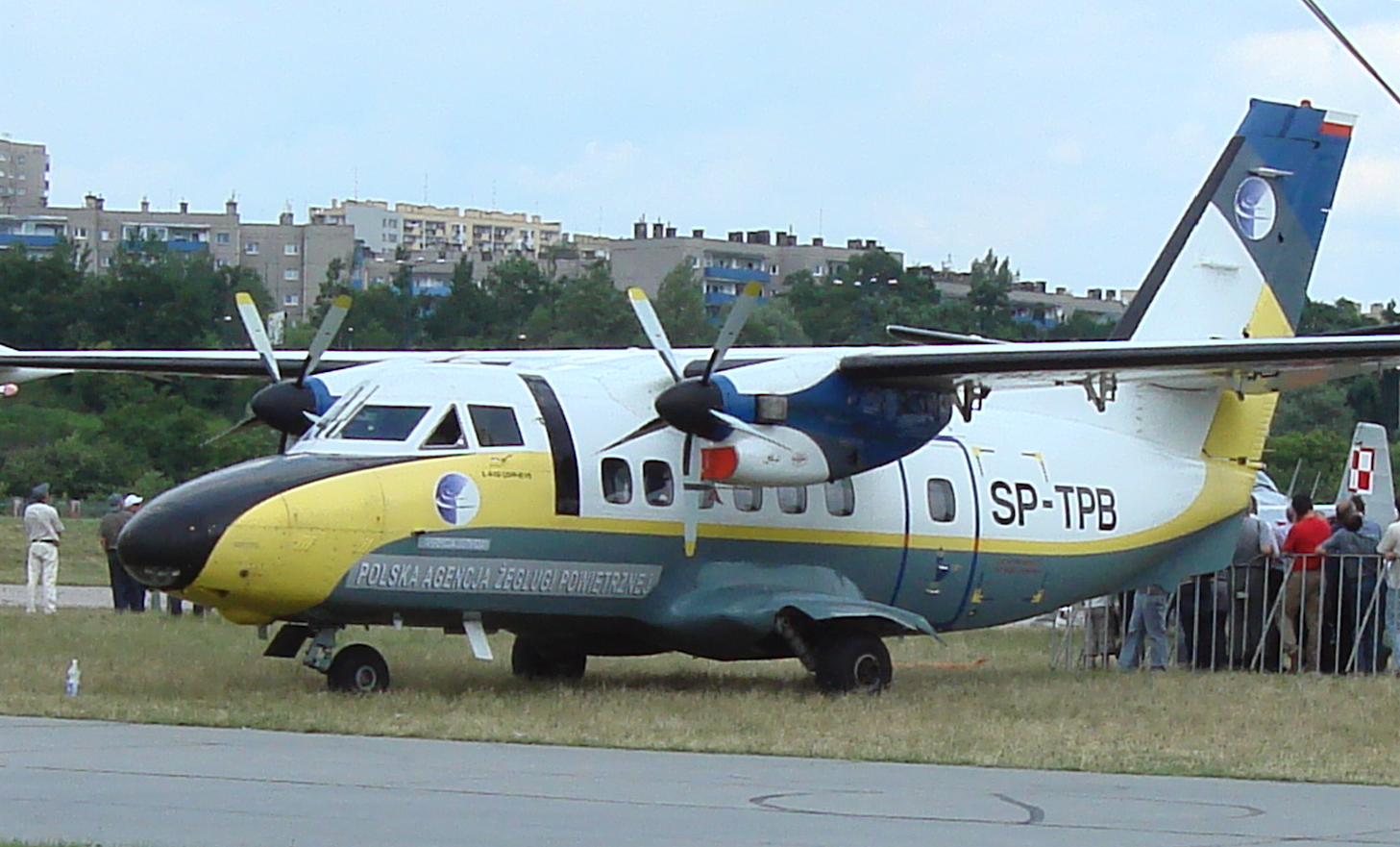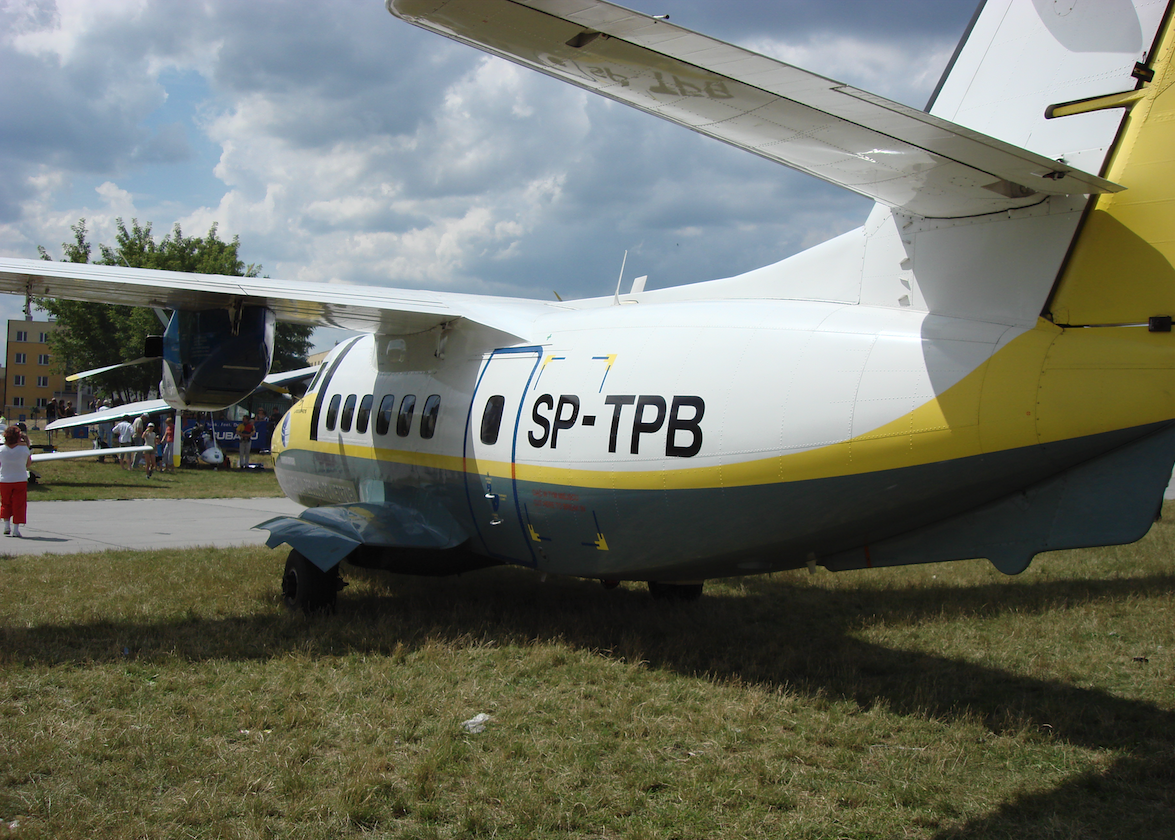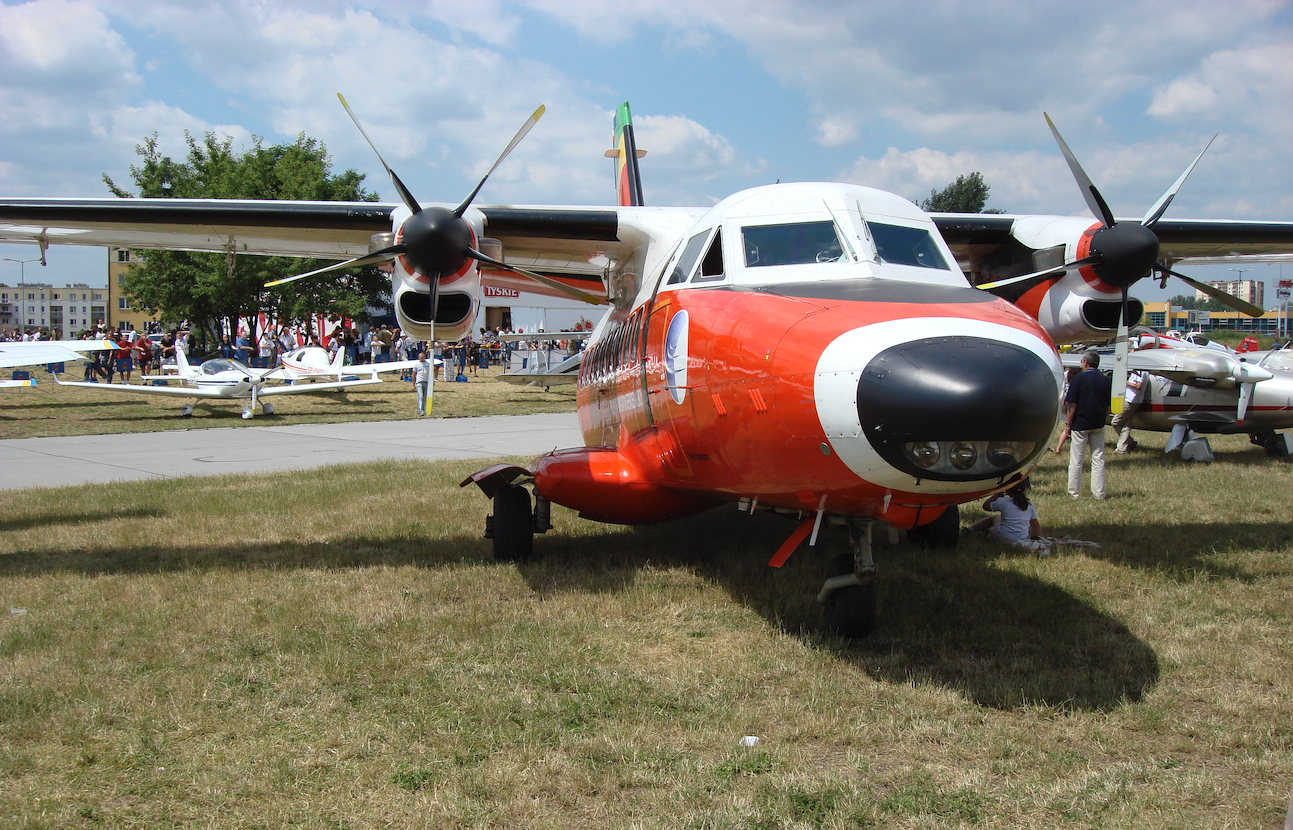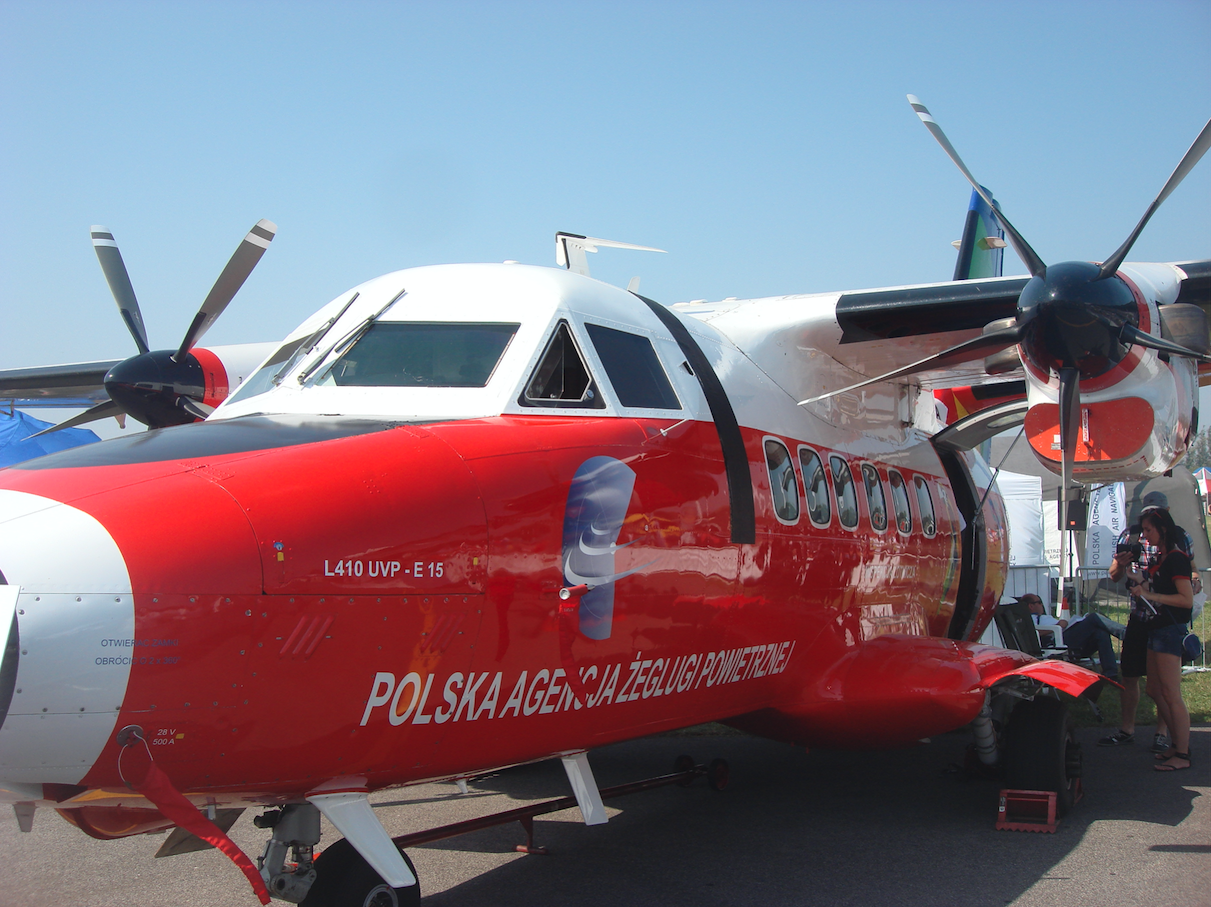Kraków 2022-08-25
Parrot. LET L-410 Turbolet. Polish Air Navigation Services Agency.




LET L-410 Turbolet in Poland.
The first Polish company to purchase the L-410 UVP Turbolet plane was Przedsiębiorstwo Usług Lotniczych AEROPOL from Warsaw, which was based at the Bemowo Airport. It was in May 1988. The L-410 UVP Turbolet aircraft No. 882038 received registration SP-TAA. The plane was made in the passenger version with 18 passenger seats (2-1x6). In the first period, its pilots were gentlemen; Zbigniew Karpiński, Jan Kolba and Józef Salwa. In the following years, AEROPOL purchased two more machines; SP-TAB, SP-TAC. The planes were painted in brown, orange and white tones.
As early as 1989, four L-410 Turbolet planes were in operation in Poland: the Aeropol company had 2 planes, the Maritime Office 1 plane, the Sanitary Aviation Team in Rzeszów 1 plane. In 1999, there were 23 L-410 Turbolets in Poland.
L-410 aircraft were also operated, in the first decade of the 21st century, by companies whose life on the Polish market was very short. Among others, the White Eagle Aviation company operated the L-410 aircraft, registration SP-FTN, and the Air Polonia company, the L-410 aircraft, registration SP-KPZ.
In 2006, there were 10 L-410 Turbolets in Poland, and in 2007, there were 7. Individual companies (entities) had 1-3 planes. In 2020, the Border Guard acquired two new L-410 Turbolet aircraft.
Parrot.
Undoubtedly, the most famous L-410 Turbolet planes in Poland were those operated by ARL (Air Traffic Agency), which were bought in 1989. PANSA, the successor of ARL, until 2016 had two Turbolet L-410 UVP-E-15 planes with registration marks SP-TPA and SP-TPB. These were airplanes equipped with specialized apparatus for calibrating blind landing devices. In 2010, two new ILS testing kits were purchased for these aircraft. The previous measuring equipment using radiotelemetry worked with a terrestrial, optical tracking system (theodolite), which was a reference point in measurements. If an error of indication outside the acceptable tolerances was found, the operator-inspector ordered its correction by radio by ground operating services.
The standard crew on the L 410 aircraft was composed of several people. Two pilots, two specialist-operator-inspectors and an on-board mechanic. Additionally, there could be two trainees or inspectors. Sometimes there were random visitors who were lucky enough to get a permit to fly. The plane was not that big, so you felt a bigger gust of wind and a change of course and altitude. The basic working device was a special computer with a database, which was connected to two workstations equipped with screens.
The task performed by the Parrot L-410 was extremely important for the safety of commercial aviation. These multiple (sometimes about 100 times) landing approaches were interrupted just above the RWY and were used to calibrate the blind landing systems, mainly the ILS system. After the fourth turn, the plane goes to the last straight. It descends unevenly, losing the ceiling, it is faster then slower. He made turns a few degrees to the left or right. Right in front of the sight on the RWY, the pilot increased the speed of the engines and goes up for another approach. And so to boredom. The casual observer on board initially felt pleased to be involved in such an important task. However, in the 10th time he was about to come and he wanted to be on the ground. Certifying the ILS system was a tedious task. It sometimes lasted several days and the weather conditions had to be favorable. In order for a commercial plane to land safely in bad weather conditions, the ILS system must transmit a precise signal. (ILS is covered in other articles in the Navigation section). The same applies to new devices as well as those already in use, and regardless of their class.
The name Parrot was born spontaneously at the turn of the 1950s and 1960s for the Iliuszyn Il-14 aircraft, which was used to test blind landing devices, and was painted in an exceptionally colorful way. Now, the name Parrot is the official name of the L 410 aircraft and their successors, and is the aircraft's watchword.
The L-410 aircraft was no longer a modern construction. The cabin is not pressurized. There was a lot of vibration and noise. However, its cubature was large for these tasks. The cabin was also easily adaptable to new specialist equipment. You should also know that in other European countries, smaller planes are used for these tasks. Two sets of specialized equipment, bought in 2010, cost PLN 18 million, so they were worth more than the planes themselves. Compared to the previous apparatus, the new one had the ability to use the GPS system, so the precision of the location of the aircraft in the air increased significantly. The operator-inspector at his position had two LCD screens, a distribution panel with switches and sockets, and a computer keyboard. The output of a particular ILS system was placed on a pen-drive and the patterns were stored at the company's premises. It used to be a computer floppy disk.
As for the GPS system, it is calibrated before flight. With a typical accuracy of a few meters (as is the case in car navigation), an accuracy of 5-10 cm is achieved! Its essential element is placed stationary on the take-off area in the appropriate place. In the cockpit, the first pilot (captain) additionally had a small interface located on the steering wheel. Using it, he properly piloted the plane. All communication between the pilots and the operator takes place via the interface or automatically. There were no interviews on board. The duration of the task was limited by the fuel taken by the plane and did not exceed three hours. The interruption was caused by a scheduled cruise or a significant deterioration of the weather. The tasks were performed in stages. First, the compliance of the approach path was checked. Then the operation of locators, and finally the efficiency of rangefinders. During flights, adjustments to plans were usually needed and additional circles had to be made. This was due to the characteristics of the radio signal reflected from the ground, especially from obstacles; trees and shrubs, lanterns, fences, water reservoirs, etc. There were only a few typical approaches. All the next ones were checking the so-called sector, that is, flights under and over the path and to the left and right. When the operator has selected the number of the test to be performed, this information goes to the autopilot and to the screen in front of the first pilot (captain). Depending on the test, the plane was between 6 NM (9 656 m) and 10 NM (16 093 m) after the fourth turn. After each flight, the operators relayed information to the ground to the crew that was carrying out the ILS regulation. Especially with the newly installed ILS devices, almost 100 raids had to be made. Parrot planes were based at Okęcie Airport. There was no homing at the airport for which the ILS was tested. Landing at such an airport took place only to refuel the Parrot plane. After the regulation of the ILS system, it obtained an airworthiness certificate for a period of 6 months. Additional checks may also have been carried out.
Aviation Inspection.
In 2007, the Air Traffic Agency was reorganized and replaced with the Polish Air Navigation Services Agency (PANSA). Within its structures, the Aviation Operations Department was created, including, inter alia, a cell called Aviation Inspection. It is this cell that deals with flights on the "Parrot" planes. The Aviation Inspection supervises the proper operation of ground-based air traffic security devices, in accordance with the recommendations of the International Civil Aviation Organization (ICAO), of which Poland is a member.
The scope of devices controlled by the Aviation Inspection increased because, after Poland joined NATO, control over Polish airspace was taken over by civilian authorities. Previously, this task was performed by the Polish Army.
There are over 150 devices and systems that are subject to control in Poland. These are devices on the landing approach paths and airways. These are systems and devices such as: instrument landing systems (ILS), omni-directional beacons (VOR and DVOR), radio-range finders (DME), non-directional beacons (NDB), navigation light systems, precise glide path indicators (PAPI), radars (radar stations).
Controls are performed periodically, on an ad hoc basis and on a commission basis. To perform these tasks, specially adapted Turbolet L-410 UVP-E 15 measuring planes "Parrot" with registration marks SP-TPA and SP-TPB were used.
End of service for LET L-410 UVP-E15 Turbolet, SP-TPA, SP-TPB aircraft.
In 2012, a decision was made to purchase new "Papug" aircraft, which replaced the LET L-410 UVP-E15 Turbolet, SP-TPA, and SP-TPB aircraft.
The L-410 UVP-E15 Turbolet, SP-TPB registration aircraft, was produced in 1989. In 2016, the total flight time of the aircraft was 6,403 hours, and after the overhaul (R2), 1,653 hours. In May 2016, the intention to sell this aircraft was announced. The reason was the acquisition in 2016 of the new "Parrot" Beechcraft B-350i Super King Air aircraft. The aircraft made its first test flight on March 8, 2016. The task concerned the control of the ILS / DME landing systems at the Zielona Góra - Babimost airport. Specialist equipment was removed from the L-410 SP-TPB aircraft. Passenger seats have been installed. The plane was bought by the Czech company Aeroservis, registering it with the OK-TPB marks.
In May 2021, the second "Parrot" LET L-410 UVP-E15 Turbolet, SP-TPA aircraft was put up for sale. The aircraft was in service for 32 years. On May 31, 2021, the technical service life of the airframe and engines was exhausted.
Written by Karol Placha Hetman
